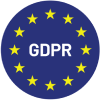Quick Summary
- Focus your journey map on a single persona, clear goals, and the touchpoints that most impact conversion or retention.
- Assign clear ownership for each stage so insights turn into real improvements rather than one-off documentation.
- Use multi-source customer data to validate pain points and prioritize fixes with the highest ROI.
- Keep maps simple, visual, and regularly updated so teams can act quickly and improve the experience continuously.
If we’re talking about big-picture concepts like the human condition, it’s the former. If we’re thinking on a small scale, like getting home after a long day of work, it’s the latter.
If we’re considering customers interacting with your brand and ultimately making a purchase, however, it’s both. Data from Salesforce found that 80% of customers now consider the experience a company provides to be as important as its products or services. As a result, companies must understand the impact of every touchpoint, from initial contact to content engagement, product consideration, and sales conversion.
Customer journey maps are critical in this process.
Journey maps visually represent the customer experience, touchpoint by touchpoint. These maps align teams around customer goals, pain points, and moments that matter across all stages of the consumer lifecycle. Strong maps include customer personas, stages, touchpoints, emotions, pain points, and success metrics that enable both clarity and actionability.
In this piece, we’ll explore journey mapping basics and offer 10 examples to help showcase maps in action. Then, we’ll deliver a repeatable framework and practical guidance to help prioritize efforts that move customer experience (CX) metrics.
Customer Journey Mapping Basics
Journey maps for customers have only two hard-and-fast rules:
1) They must be visual — something that teams can see.
2) They must be understandable. If maps require long-winded explanation or accompanying documentation, they’re too complex.
Visual and understandable, however, don’t guarantee insight. Successful journey maps share three components:
Clear scope and goals
Scope defines the journey itself: Are you looking to measure the customer journey from end-to-end, or create a micro-journey map that examines consumer experiences with a specific part of the process, such as initial engagement or the purchase process? Scope also speaks to persona. Choose a single customer type to track, rather than trying to compile data on multiple buyer preferences.
Goals are what you hope to gain. For example, are you looking to measure engagement rates? Website interactions? The timeline for initial purchases or the likelihood of repeat purchases? By ensuring your scope and your goals align, you can improve the accuracy of mapping outcomes.
Multi-source data gathering
While data from a single source helps provide point-in-time insight, using multiple sources offers context. Start by taking inventory of your channels and touchpoints, then carry out surveys and interviews, and combine these results with transaction, customer service, and social media data to get the big picture.
Well-defined stages, metrics, and ownership
Great maps don’t happen by accident. Clearly define the stages of your customer journey and identify possible friction points in the collection and analytics process. Then, pinpoint metrics that matter, decide who “owns” the process to ensure accountability, and set a specific cadence for map reviews to ensure they remain actionable.
10 Customer Journey Map Examples
The journey map that works best for you depends on your industry, customer pain points, and channel mix. But this doesn’t mean you need to reinvent the wheel — here are 10 journey map examples to help get you started.
1) Spotify
Music streaming service Spotify wanted to improve the sharing experience for listeners and created a B2C journey map to do just that:
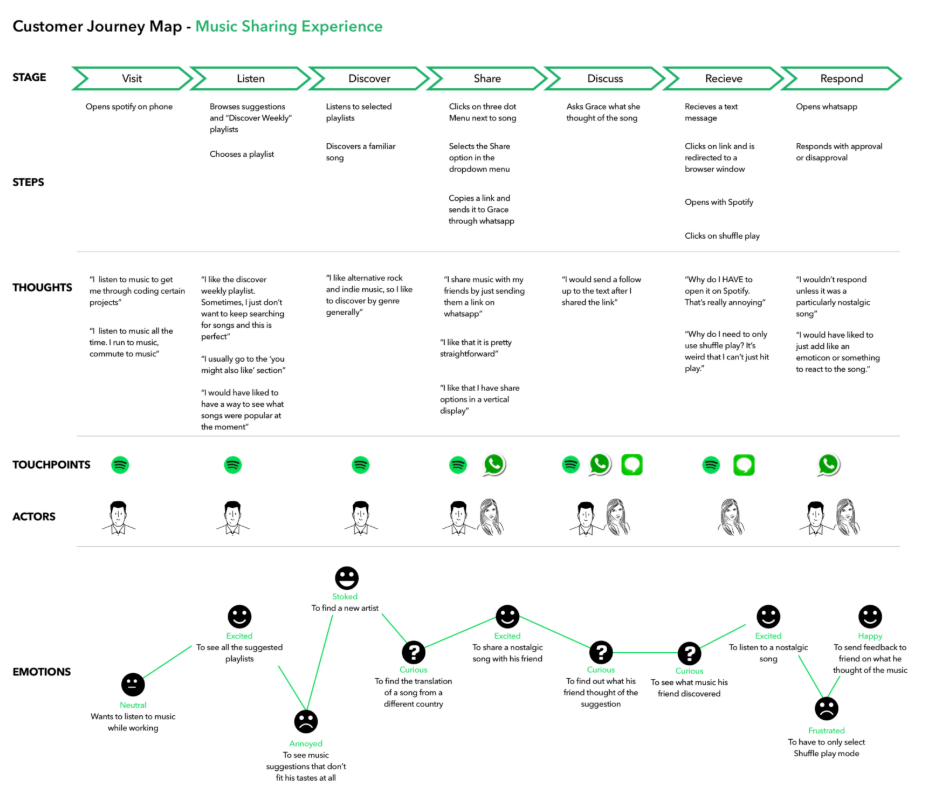
2) HubSpot
CRM provider HubSpot dove into the journey mapping space with a color-coded approach that included testimonials from users:

3) Intuit
TurboTax developer Intuit wanted to gauge customer response to a new product, Personal Pro, and created a customer journey map to do just that:
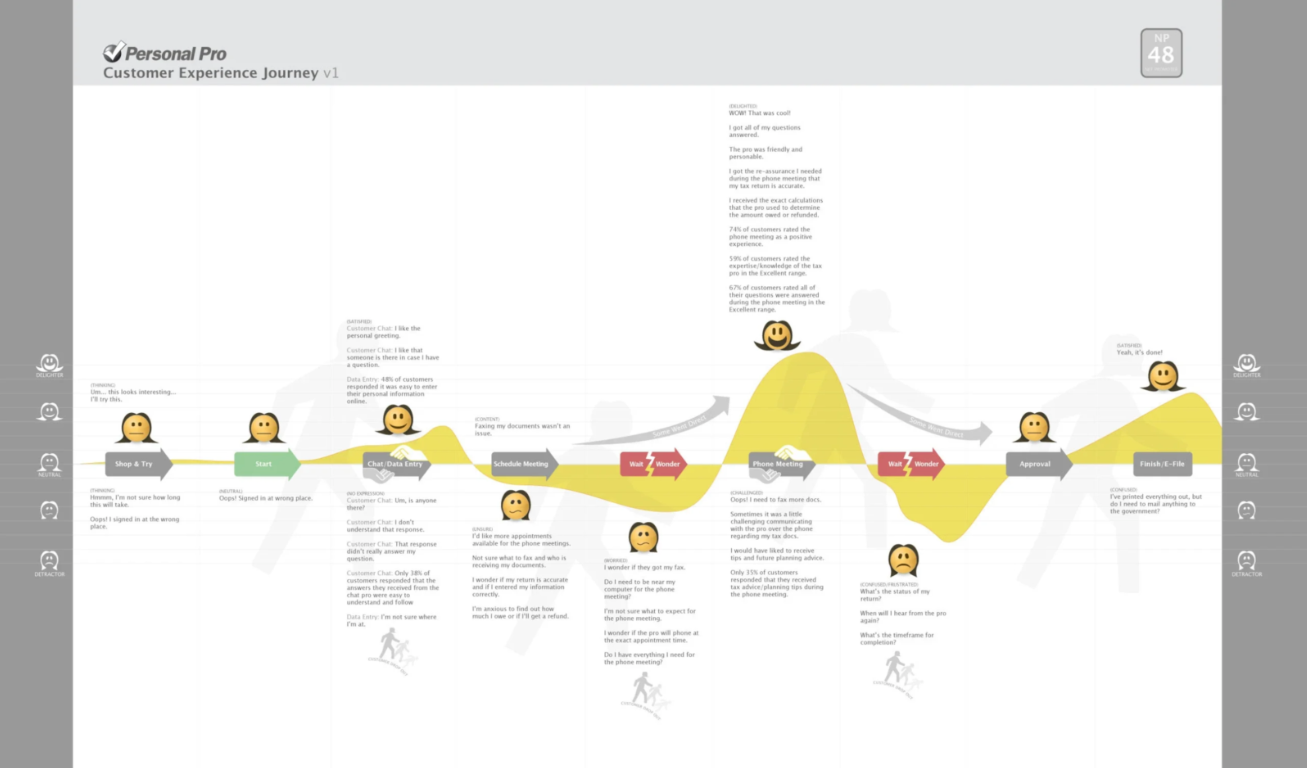
4) Amazon
No surprise here — ecommerce giant Amazon is all about creating customer journey maps to better understand what buyers want:

5) Netflix
Using a fictional persona that’s an amalgam of real users, Netflix’s customer journey map examined what happens when customers don’t do the expected. Instead of using Netflix recommendations, the user, “Jen”, opted for manual search. Mapping this journey helps the company improve its search algorithm:
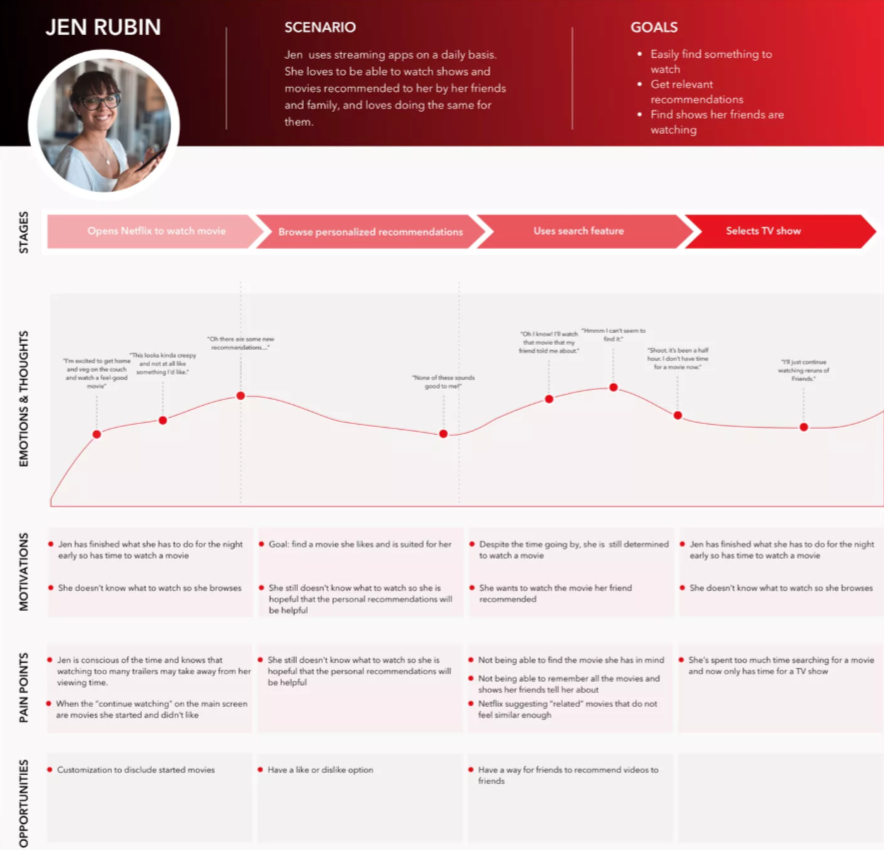
6) Starbucks
Coffee chain Starbucks dove into the journey of a repeat customer and tracked multiple touchpoints, from arrival to engagement to departure and reflection:

7) The Department of Veterans Affairs
Using a journey map helped the VA better understand the patient experience in VA hospitals by visualizing both the steps of the process and the potential emotions, thoughts, and pain points experienced by veterans:
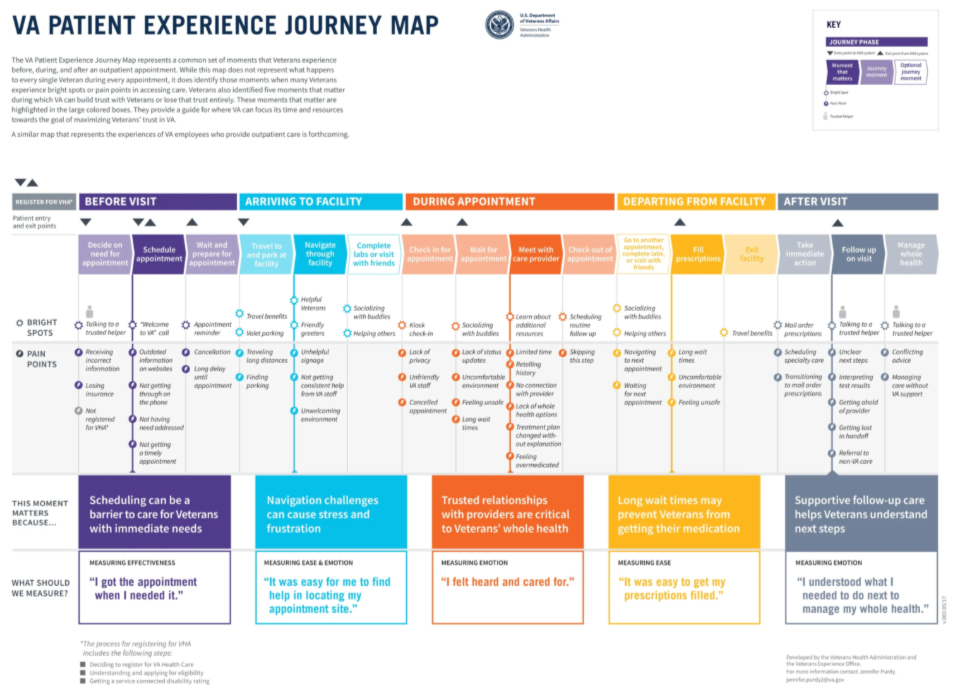
8) Rail Europe
Rail Europe designed a journey map to help pinpoint where travelers experienced pain points and what qualitative insights could be gleaned and applied:

9) Lancome
Cosmetics company Lancome created a journey map that tracked all stages of customer interaction, from considering purchases to entering stores to making reviews after their experience:
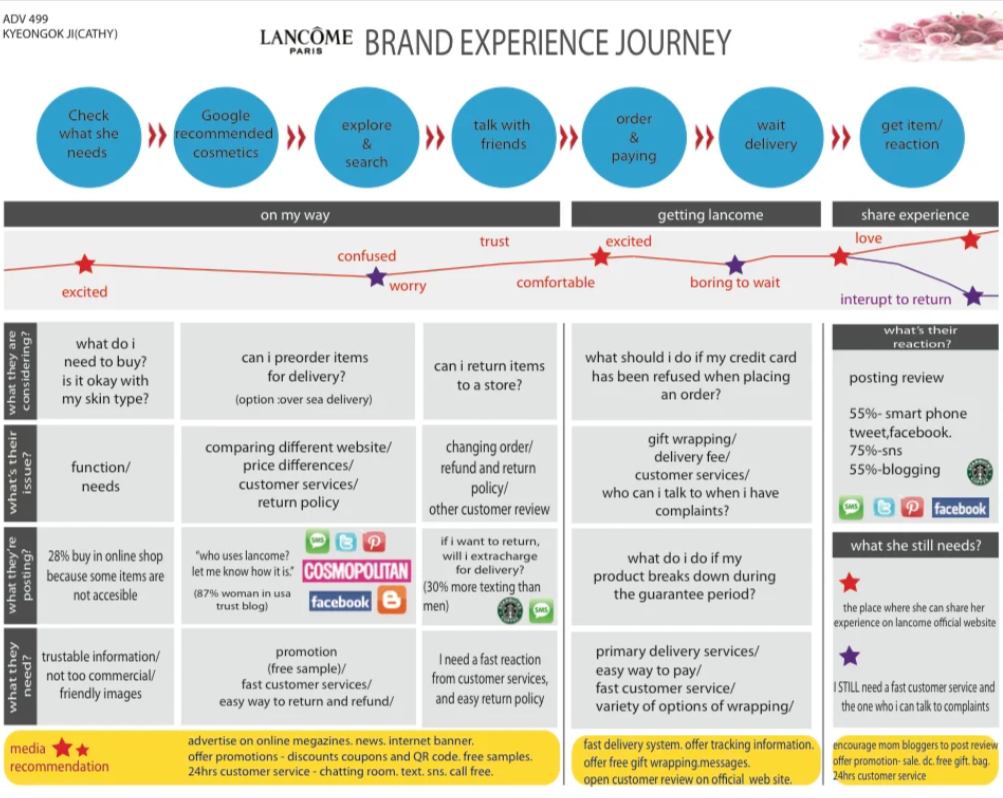
10) IKEA
Swedish furniture giant IKEA is known for its curated in-store experience, and created a customer journey map to identify potential pain points, such as picking stock and managing deliveries:
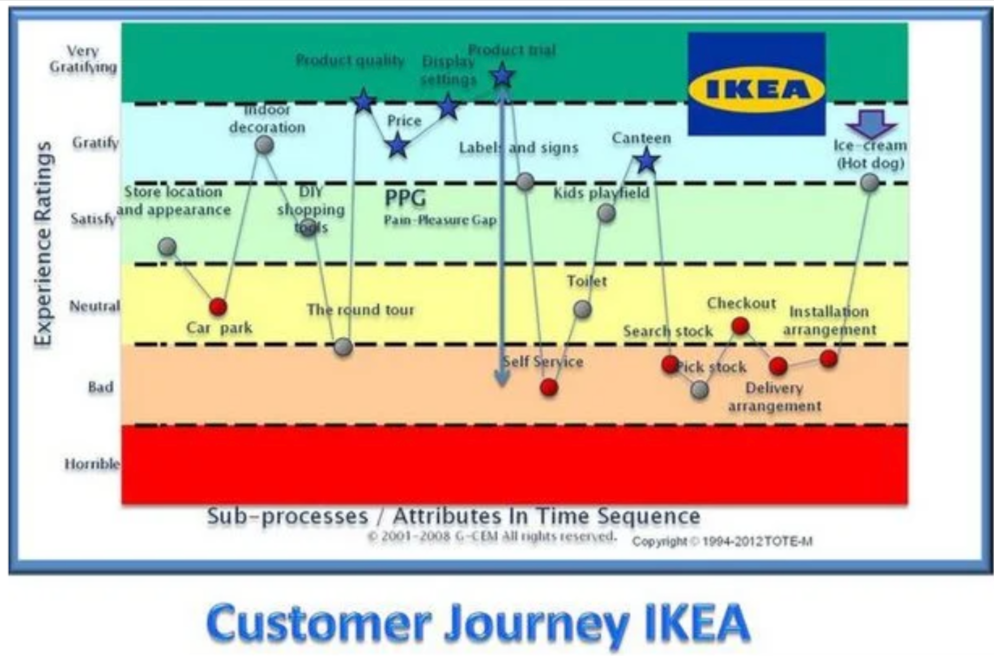
Build Your Customer Journey Map
To build your customer journey map, follow these three steps:
Step 1: Capture the Voice of the Customer
If you don’t listen to the VoC, your journey maps won’t offer useful directions. Make sure you’re capturing VoC at key touchpoints with contextual surveys that measure customer satisfaction score (CSAT), net promoter score (NPS), and customer effort score (CES). In addition, include open-text options to help surface emotional drivers.
Step 2: Map stages and prioritize pain points
Next, map the stages you plan to measure and identify pain points in each of those stages. Then, segment stages by persona and channel to help identify the highest ROI fixes.
Step 3: Close the loop with alerts, dashboards, and feedback
Alerts and dashboards let you see what’s happening in real time. It’s also important to assign ownership — maps aren’t useful if no one is in charge of navigation. Regularly gather feedback and track customer behavior changes over time to ensure maps stay current.
Making the Most of Journey Maps for Revenue Impact
To make the most of journey maps, follow these best practices:
- Start small
- Validate with data
- Iterate fast
- Use consistent metrics
- Avoid one-off artifacts
- Keep maps people-first and evidence-driven
Customer journey maps point you in the right direction, but you need to follow the trail. Start small, always validate, and iterate often to make sure you’re heading the right way.
Capture critical customer data with survey solutions from Sogolytics. Get started today.
FAQs About Customer Journey Mapping
What are the key elements of customer journey mapping?
There are two key elements of a customer journey map.
First, it must be visual — something that sales, marketing, and C-suite teams can see.
Second, it must make sense. Maps should not require extensive explanations or qualifications. Instead, users should be able to quickly find the information they need.
How many stages should a customer journey map include?
Customer journey maps have five stages:
- Awareness
- Consideration
- Decision
- Retention
- Advocacy
What data sources best validate a journey map’s pain points?
Sources such as surveys, interviews, and support logs provide insight into customer pain points.
How often should journey maps be updated and reviewed?
Journey maps should be reviewed monthly or quarterly. Update schedules are less rigid — update maps whenever there is a significant change to customer service processes or pain points.




